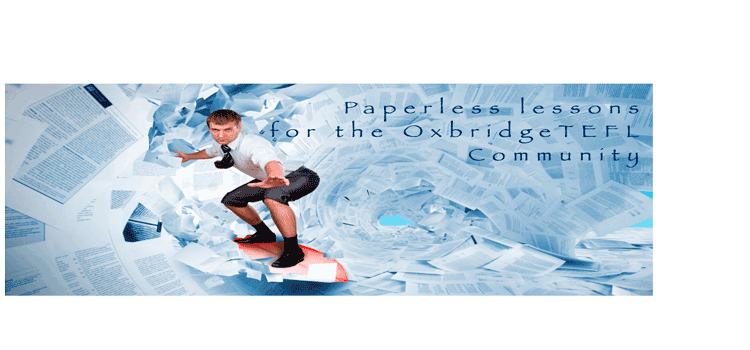Ready-to-use paperless lessons are now a reality for the OxbridgeTEFL community members due to the implementation of an integrated system of online management of the teaching/learning process. Not only there is no single paper wasted for a lesson plan, but also both teachers and students are now able to evaluate the teaching process in real time. Taking the register is no longer a paper dependent process and students can access the same learning content as teachers for their classes.
In a previous blog I discussed the fact that I believe teaching is an art and, because of this, it means that every teacher has a different style of teaching. This doesn't make a teacher any better or worse than another teacher, it just means their classes have a personal touch.
Some teachers write their own material, some use text books and others follow a curriculum. At
OxbridgeTEFL, the teachers write their own material and pool it so that the other teachers in the community are able to use them. Each of these lessons follow a format whereby one or more (given time constraints) Topic, Structure and Vocabulary activity is taught and each activity (irrespective of type) consists of an objective, the body of the activity, target language and wrap-up. In my opinion this system works well as the teachers are able to write the activity in their own style and, in turn, the students get to learn every aspect of the English language in each class and be taught in a different way by each teacher. In addition, the activities are evaluated by the teachers as to which ones worked well and which ones were not so good. The not so good activities are then either removed from circulation or, improved upon.
The process of allocating the lesson plans means masses of paper is used to print the material which is then handed out to the teachers whose job it is to ensure that it is all correctly printed (no attachments missing, etc) and then we have to carry it to our lessons. This is a bit of a chore, to say the least, as well as a waste of paper, ink and time. However, the system has now been dramatically improved. Given that this is the age of technology, the founders of Oxbridge decided that it would make more sense to be able to access lessons via a tablet or laptop (or mobile even). And, we are now able to do just that. Yippee!
Due to paper we have had centuries of world knowledge in our hands. Books have been an incredible tool to transmitting knowledge, culture, values, stories...but, paper also has its limitations. Once printed, it cannot be modified until the next edition. Textbooks have a shelf live and they quickly become obsolete. Interactivity, as understood in today's technological era, is non-existent. New devices have emerged to cover new necessities and take the educational projects even further. Now we can store hundreds of books in our tablets, access the Internet with our smart phones and create and edit educational material in real time. We have the latest updates with economy of time, weight and money!
Do you remember how your teacher used to take the register in class? With a digital device, it now takes just a click to update the register and track attendance rate for each student.
Who can forget the old tapes which used to go with your language textbooks? The CD came along to replace it and then we had
YouTube and
Vimeo. Our activities now contain video excerpts with the exact duration and moment featured in the activity: A part of a film that contains passive voice? The latest breaking news? We have the activity and we now have the video to go with it, along with its target language and comprehension or debate questions.
Many times we are asked to provide concrete proof of the progress of a student. As hard as it can be (I always compare it with watching a child grow) we are now able to assess the content acquisition of each individual student after each individual class! Progress graphs, content acquisition tracking, needs analysis are now easier than ever and much more personalized and precise. With such information we can personalize lesson plans too at the same speed learning happens. 'Smileys' are now indicators for content acquisition and they determine what content to plan to each group or student without spending long hours analyzing stats.
One to five, how many stars would you give to the trendiest restaurant in town? And to the last activity you did? Knowing how the teacher feels about the material they use is precious information to know which activities we can continue using and which ones need removing or improving. That will potentially increase enormously the quality of our teaching material until we only present 5 star activities to students.
Not only do we not have to sieve through large amounts of material and carry it around with us, we are also able to teach classes using a projector or TV screen and can now incorporate video clips too. It also puts paid to having to remember how good or bad your students are doing when having to assess them after the class as, you can do this on the spot while taking the lesson.
Paperless lessons means a total paper-free life in the classroom.
This new system was tested by several teachers over the course of a week and found to be a success so, it will be put into play this week. Good riddance to paper!
If you are in a position where you are using text books or carrying heaps of paper around with you, maybe it's time you jumped on the bandwagon. Click
HERE to arrange a free, no obligation interview and join our paper-free community....
...what have you got to lose, apart from a load of paperwork!
